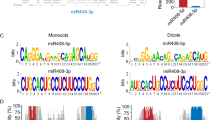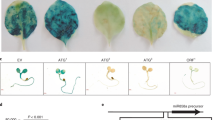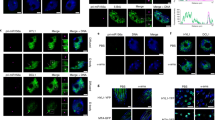Abstract
MicroRNAs (miRNA) regulate key aspects of development and physiology in animals and plants. These regulatory RNAs act as guides of effector complexes to recognize specific mRNA sequences based on sequence complementarity, resulting in translational repression or site-specific cleavage1,2. In plants, most miRNA targets are cleaved and show almost perfect complementarity with the miRNAs around the cleavage site3,4,5,6,7,8. Here, we examined the non–protein coding gene IPS1 (INDUCED BY PHOSPHATE STARVATION1) from Arabidopsis thaliana. IPS1 contains a motif with sequence complementarity to the phosphate (Pi) starvation–induced miRNA miR-399, but the pairing is interrupted by a mismatched loop at the expected miRNA cleavage site. We show that IPS1 RNA is not cleaved but instead sequesters miR-399. Thus, IPS1 overexpression results in increased accumulation of the miR-399 target PHO2 mRNA and, concomitantly, in reduced shoot Pi content5,6,7,8. Engineering of IPS1 to be cleavable abolishes its inhibitory activity on miR-399. We coin the term 'target mimicry' to define this mechanism of inhibition of miRNA activity. Target mimicry can be generalized beyond the control of Pi homeostasis, as demonstrated using artificial target mimics.
This is a preview of subscription content, access via your institution
Access options
Subscribe to this journal
Receive 12 print issues and online access
$209.00 per year
only $17.42 per issue
Buy this article
- Purchase on Springer Link
- Instant access to full article PDF
Prices may be subject to local taxes which are calculated during checkout




Similar content being viewed by others
References
He, L. & Hannon, G.J. MicroRNAs: small RNAs with a big role in gene regulation. Nat. Rev. Genet. 5, 522–531 (2004).
Bartel, D.P. MicroRNAs: genomics, biogenesis, mechanism, and function. Cell 116, 281–297 (2004).
Jones-Rhoades, M.W., Bartel, D.P. & Bartel, B. MicroRNAs and their regulatory roles in Plants. Annu. Rev. Plant Biol. 38, 19–53 (2006).
Mallory, A.P. & Vaucheret, H. Functions of microRNAs and related small RNAs in plants. Nat. Genet. 38, S31–S36 (2006).
Allen, E., Xie, Z., Gustafson, A.M. & Carrington, J.C. microRNA-directed phasing during trans-acting siRNA biogenesis in plants. Cell 121, 207–221 (2005).
Schwab, R. et al. Specific effects of microRNAs on the plant transcriptome. Dev. Cell 8, 517–527 (2005).
Vazquez, F. et al. Endogenous trans-acting siRNAs regulate the accumulation of Arabidopsis mRNAs. Mol. Cell 16, 69–79 (2004).
Simón-Mateo, C. & García, J.A. MicroRNA-guided processing impairs Plum pox virus replication, but the virus readily evolves to escape this silencing mechanism. J. Virol. 80, 2429–2436 (2006).
Fujii, H., Chiou, T.J., Lin, S.I., Aung, K. & Zhu, J.K. A miRNA involved in phosphate-starvation response in Arabidopsis. Curr. Biol. 15, 2038–2043 (2005).
Chiou, T.J. et al. Regulation of phosphate homeostasis by microRNA in Arabidopsis. Plant Cell 18, 412–421 (2006).
Aung, K. et al. pho2, a phosphate overaccumulator, is caused by a nonsense mutation in a microRNA399 target gene. Plant Physiol. 141, 1000–1011 (2006).
Bari, R., Datt Pant, B., Stitt, M. & Scheible, W.R. PHO2, MicroRNA399, and PHR1 define a phosphate-signaling pathway in plants. Plant Physiol. 141, 988–999 (2006).
Poirier, Y. & Bucher, M. Phosphate transport and homeostasis in Arabidopsis. in The Arabidopsis Book (eds. Sommerville, C.R. & Meyerowitz, E.M.) (American Society of Plant Biologists, Rockville, Maryland, 2002).
Ticconi, C.A. & Abel, S. Short on phosphate: plant surveillance and countermeasures. Trends Plant Sci. 9, 548–555 (2004).
Franco-Zorrilla, J.M. et al. The transcriptional control of plant responses to phosphate limitation. J. Exp. Bot. 55, 285–293 (2004).
Burleigh, S.H. & Harrison, M.J. A novel gene whose expression in Medicago truncatula roots is suppressed in response to colonization by vesicular-arbuscular mycorrhizal (VAM) fungi and to phosphate nutrition. Plant Mol. Biol. 34, 199–208 (1997).
Burleigh, S.H. & Harrison, M.J. The down regulation of Mt4-like genes by phosphate fertilization occurs systemically and involves phosphate translocation to the shoots. Plant Physiol. 119, 241–248 (1999).
Liu, C., Muchhal, U.S. & Raghothama, K.G. Differential expression of TPSI1, a phosphate starvation-induced gene in tomato. Plant Mol. Biol. 33, 867–874 (1997).
Martín, A.C. et al. Influence of cytokinins on the expression of phosphate starvation responsive genes in Arabidopsis. Plant J. 24, 559–567 (2000).
Shin, H., Shin, H.S., Chen, R. & Harrison, M.J. Loss of At4 function impacts phosphate distribution between the roots and the shoots during phosphate starvation. Plant J. 45, 712–726 (2006).
Vaucheret, H., Vazquez, F., Crete, P. & Bartel, D.P. The action of ARGONAUTE1 in the miRNA pathway and its regulation by the miRNA pathway are crucial for plant development. Genes Dev. 18, 1187–1197 (2004).
Axtell, M.J., Rajagopalan, R. & Bartel, D.P. A two-hit trigger for siRNA biogenesis in plants. Cell 127, 565–577 (2006).
Wu, G. & Poethig, R.S. Temporal regulation of shoot development in Arabidopsis thaliana by miR156 and its target SPL3. Development 133, 3539–3547 (2006).
Palatnik, J.F. et al. Control of leaf morphogenesis by microRNAs. Nature 425, 257–263 (2003).
Franco-Zorrilla, J.M., Martin, A.C., Leyva, A. & Paz-Ares, J. Interaction between phosphate-starvation, sugar, and cytokinin signaling in Arabidopsis and the roles of cytokinin receptors CRE1/AHK4 and AHK3. Plant Physiol. 138, 847–857 (2005).
Ames, B.N. Assay of inorganic phosphate, total phosphate and phosphatases. Methods Enzymol. 8, 115–118 (1966).
Baulcombe, D.C., Saunders, G.R., Bevan, M.W., Mayo, M.A. & Harrison, B.D. Expression of biologically active viral satellite RNA from the nuclear genome of transformed plants. Nature 321, 446–449 (1986).
Bechtold, N., Ellis, J. & Pelletier, G. In planta Agrobacterium mediated gene transfer by infiltration of adult Arabidopsis thaliana plants. CR Acad. Sci. Paris Life Sci. 316, 15–18 (1993).
Jiménez, I., López, L., Alamillo, J.M., Valli, A. & García, J.A. Identification of a plum pox virus CI-interacting protein from chloroplast that has a negative effect in virus infection. Mol. Plant Microb. Interact. 19, 350–358 (2006).
González, E., Solano, R., Rubio, V., Leyva, A. & Paz-Ares, J. PHOSPHATE TRANSPORTER TRAFFIC FACILITATOR1 is a plant-specific SEC12-related protein that enables the endoplasmic reticulum exit of a high-affinity phosphate transporter in Arabidopsis. Plant Cell 17, 3500–3512 (2005).
Acknowledgements
We thank C. Aragoncillo, C. Castresana, M. Crespi, C. Martin, S. Prat, R. Solano and H. Vaucheret for reading the manuscript and C. Mark for editorial assistance. Technical assistance by M.J. Benito is acknowledged. We also thank the European Arabidopsis Stock Centre (NASC) stock centre for providing plant material. A.V. is supported by a fellowship from CSIC–Fondo Social Europeo (FSE), and I.M. and I.R.-S. by fellowships from the Spanish Ministry of Science and Education (MEC). Primary support for this work was provided by grants from the European Union, Comunidad de Madrid and MEC. Additional support came from the Marie Curie Research Training Network SY-STEM (M.T.) and the Max Planck Society (D.W.).
Author information
Authors and Affiliations
Contributions
J.M.F.-Z. was responsible for experiments in Figure 1 and Supplementary Figures 1, 2, 3, 4 and 5 and prepared constructs and performed RNA blot analysis corresponding to Figures 2, 3. A.V. performed transient expression assays in Figures 2, 3 and Supplementary Figure 5. M.I.P. and I.M. prepared constructs and performed Pi measurements shown in Supplementary Figure 3. M.T. and I.R.-S. performed the artificial mimicry experiments shown in Figure 4. D.W. supervised the artificial mimicry experiments in Figure 4. J.A.G. supervised the transient expression assays in Figures 2,3 and Supplementary Figure 5 and contributed to discussion of other experiments. J.P.-A. supervised this study and wrote the manuscript. A.L. contributed to supervision and general discussion. J.A.G., D.W., J.M.F.-Z. and all other authors commented on the manuscript.
Corresponding author
Ethics declarations
Competing interests
The authors declare no competing financial interests.
Supplementary information
Supplementary Text and Figures
Supplementary Table 1, Supplementary Figures 1–5, Supplementary Methods (PDF 941 kb)
Rights and permissions
About this article
Cite this article
Franco-Zorrilla, J., Valli, A., Todesco, M. et al. Target mimicry provides a new mechanism for regulation of microRNA activity. Nat Genet 39, 1033–1037 (2007). https://doi.org/10.1038/ng2079
Received:
Accepted:
Published:
Issue Date:
DOI: https://doi.org/10.1038/ng2079
This article is cited by
-
Regulation of coconut somatic embryogenesis: decoding the role of long non-coding RNAs
Plant Biotechnology Reports (2024)
-
From diagnosis to resistance: a symphony of miRNAs in pheochromocytoma progression and treatment response
Naunyn-Schmiedeberg's Archives of Pharmacology (2024)
-
Screening of microRNAs and target genes involved in Sclerotinia sclerotiorum (Lib.) infection in Brassica napus L.
BMC Plant Biology (2023)
-
circFNDC3B promotes esophageal squamous cell carcinoma progression by targeting MYO5A via miR-370-3p/miR-136-5p
BMC Cancer (2023)
-
Identification and interest of molecular markers to monitor plant Pi status
BMC Plant Biology (2023)



